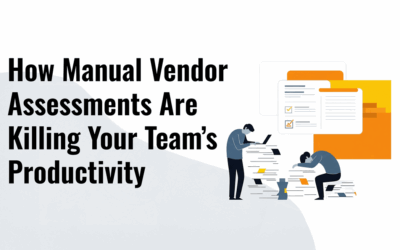In today’s interconnected world, organizations rely on a complex network of third parties to deliver their products and services. However, these third parties also have their own third-parties, known as fourth-parties, that provide them with essential functions and capabilities. For example, an IT service provider may use a cloud services provider to manage customer data or a manufacturer may outsource the production of certain components to a fourth party.
These fourth-parties pose significant risks to the organizations that ultimately depend on them. If a fourth party is breached and processes or stores your personally identifiable information (PII), it could compromise your organization’s PII. Moreover, fourth-parties pose both operational and reputational risks. If the fourth party experiences downtime or inefficiencies, it can impact the third party’s ability to deliver services to you and impair your reputation.
Therefore, enterprises must understand and manage their fourth-party risk effectively, and vendors should demonstrate their ability to mitigate their own third-party risk. In this blog post, we discuss some best practices for both enterprises and vendors to address the challenges of fourth-party risk
How to Manage Fourth-Party Risk as an Enterprise
As an enterprise that relies on third parties, you should take the following steps to manage your fourth-party risk:
Identify Key Fourth-Party Relationships
Focus on understanding fourth-party relationships as part of the risk assessment process, especially for those fourth-parties that will store or process your sensitive information. You should ask your third parties to disclose their key fourth-parties and their roles and responsibilities, as well as any contractual agreements or service level agreements that govern their relationship. Service organizational controls (SOC) reports from your vendors will likely also contain relevant information on key fourth-party relationships.
Assess Vendors on Their Vendor Risk Management Program
Assess your third parties on the quality of their vendor risk management program. You should ensure that your vendors have a robust framework and methodology for identifying, assessing, mitigating, and reporting on their third-party risks, including their fourth-party risks. You should also review their policies and procedures for selecting, contracting, onboarding, reviewing, and terminating their third-party relationships, as well as their incident response and contingency plans in case of a fourth-party failure or breach.
Continuously Monitor Key Fourth-parties
Continuously monitor key fourth parties to identify any vulnerabilities that could ultimately impact your organization. ThreatScape enables you to monitor the internet-facing attack surface of your third and fourth-parties in real-time.
How to Manage Fourth-Party Risk as a Vendor
As a vendor that provides services or products to other organizations, you should take the following steps to address the concerns of your customers and partners:
Prepare to Respond to More Security Assessments
Be prepared to respond to more questionnaires. As there is increased focus on third and fourth-party risks, you are likely to receive more security assessments from your customers, prospects, and partners. To streamline this process and reduce the burden on your resources, you should invest in tools that leverage AI to help you respond to questionnaires. Such a tool can help you standardize your responses across different formats and frameworks, automate repetitive tasks, and accelerate the completion of assessments.
Develop a Strong Third-Party Risk Management Program
There is no better way to cultivate trust with customers and partners around fourth-party risk than having a strong vendor risk management program in place to demonstrate your commitment to managing third-party risk. You should adopt a proactive and holistic approach to managing your third-party relationships, from selection to termination. You should also implement appropriate controls and measures to protect your data and systems from unauthorized access or misuse by your third parties. Moreover, you should document and communicate your risk management practices and achievements to your customers and stakeholders, to build trust and confidence in your capabilities.
How ProcessBolt Can Help
ProcessBolt offers an AI-driven vendor risk management platform that uniquely enables enterprises and vendors to address the challenges of third and fourth-party risk. The fully integrated platform enables enterprises to assess and continuously monitor their vendor networks while leveraging the latest generative AI technology to extract intelligence from vendor corporate documentation. To address the challenges that vendors need to manage, the platform leverages AI to help vendors auto-populate responses to assessments based on previously completed assessments. Get in touch today to learn more.




